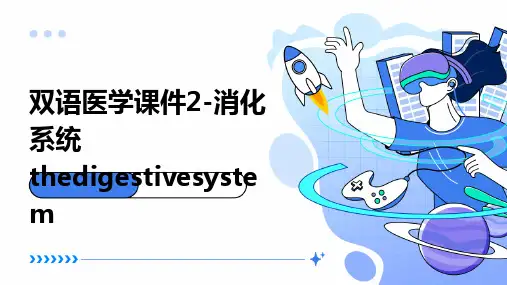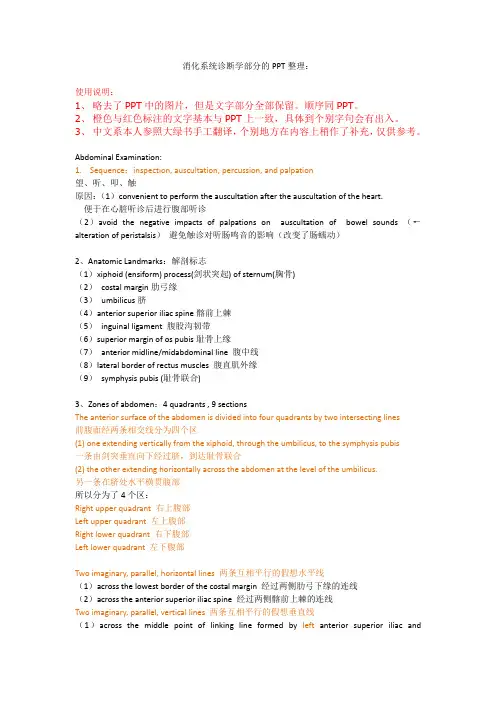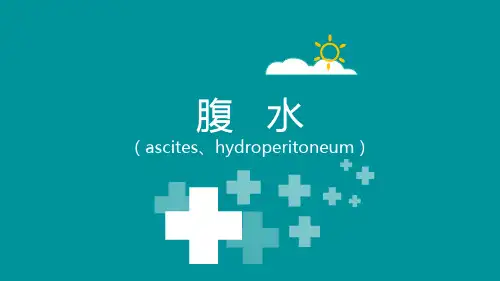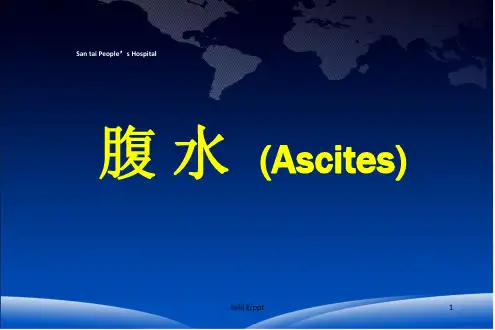消化系统诊断学PPT的word版 腹水 中英文对照版
- 格式:docx
- 大小:608.93 KB
- 文档页数:10





消化系统诊断学部分的PPT整理:使用说明:1、略去了PPT中的图片,但是文字部分全部保留。
顺序同PPT。
2、橙色与红色标注的文字基本与PPT上一致,具体到个别字句会有出入。
3、中文系本人参照大绿书手工翻译,个别地方在内容上稍作了补充,仅供参考。
Abdominal Examination:1.Sequence:inspection, auscultation, percussion, and palpation望、听、叩、触原因:(1)convenient to perform the auscultation after the auscultation of the heart.便于在心脏听诊后进行腹部听诊(2)avoid the negative impacts of palpations on auscultation of bowel sounds (←alteration of peristalsis)避免触诊对听肠鸣音的影响(改变了肠蠕动)2、Anatomic Landmarks:解剖标志(1)xiphoid (ensiform) process(剑状突起) of sternum(胸骨)(2)costal margin肋弓缘(3)umbilicus脐(4)anterior superior iliac spine髂前上棘(5)inguinal ligament 腹股沟韧带(6)superior margin of os pubis耻骨上缘(7)anterior midline/midabdominal line 腹中线(8)lateral border of rectus muscles 腹直肌外缘(9)symphysis pubis (耻骨联合)3、Zones of abdomen:4 quadrants , 9 sectionsThe anterior surface of the abdomen is divided into four quadrants by two intersecting lines前腹面经两条相交线分为四个区(1) one extending vertically from the xiphoid, through the umbilicus, to the symphysis pubis一条由剑突垂直向下经过脐,到达耻骨联合(2) the other extending horizontally across the abdomen at the level of the umbilicus.另一条在脐处水平横贯腹部所以分为了4个区:Right upper quadrant 右上腹部Left upper quadrant 左上腹部Right lower quadrant 右下腹部Left lower quadrant 左下腹部Two imaginary, parallel, horizontal lines 两条互相平行的假想水平线(1)across the lowest border of the costal margin 经过两侧肋弓下缘的连线(2)across the anterior superior iliac spine 经过两侧髂前上棘的连线Two imaginary, parallel, vertical lines 两条互相平行的假想垂直线(1)across the middle point of linking line formed by left anterior superior iliac andmidabdominal line 经过左髂前上棘至腹中线连线的中点(2)across the middle point of linking line formed by right anterior superior iliac and midabdominal line 经过右髂前上棘至腹中线连线的中点所以分为了9 sections:Right hypochondrial region右季肋部Left hypochondrial region 左季肋部Right lumber region 右腰部Left lumber region 左腰部Right iliac region 右髂部Left iliac region 左髂部Epigastric region 上腹部Umbilical region 脐部Hypogastric region下腹部4. Question : What are the distinct benefits and disadvantages in Four-quadrant and Nine-section methods? 四区法和九区法的明显优缺点?Four-quadrant :(1) simple, practical 简单实用(2) rough, imprecise 粗糙不精确(tenderness of epigastric region) (上腹部压痛)Nine-section(1) elaborates more clearly and more exactly 更清晰精确(2) inconvenient 不方便(3) limited scope of left or right hypochondrial region, left or right iliac region左、右季肋部,左、右髂部范围局限5. Inspection: General preparation 望诊的一般准备(1)urinate completely: bladder is empty 膀胱排空(2)relax abdominal muscles: lie on back with a pillow under head and knees bent 放松腹部肌肉:低枕仰卧位,双腿屈曲(3)expose abdomen completely: from xiphoid process to pubis 充分暴露腹部:上至剑突,下至耻骨联合(4)breasts should be covered: female 遮盖乳房:女性6. Inspection: major contents望诊的主要内容abdominal contour 腹部外形respiratory movements 呼吸运动abdominal veins 腹壁静脉gastral or intestinal pattern(胃型或肠型)peristalsis(蠕动波)abdominal rash(皮疹), hernia(疝), striae(纹), etc.7. Inspection: Abdominal Contour 视诊whether the abdomen is symmetrical 腹部是否对称whether it is bulged or retracted 是否膨隆或凹陷whether it is indicative of ascites or enclosed mass(包块) 是否提示有腹水或包块Normal :(1) abdominal flatness(腹部平坦) :√ abdomen at the same level or lower as between costal margin and symp hysis pubis前腹面处于肋弓缘与耻骨联合平面,或略微凹陷√ ask the patient to sit, the lower part of umbilicus can become more or less protruded or bulged要求病人坐位,脐以下部位可稍膨出(2) abdominal fullness(腹部饱满) :√ very fat or a child, the abdomen is a little bit round 肥胖者或小儿(尤其餐后)腹部外形饱满或膨隆√The level of the abdomen higher than that of the surface between costal margin and symphysis pubis 前腹面超过肋弓缘至耻骨联合平面(3) abdominal lowness(腹部低平):√ very thin or slender, the level of the abdomen lower than that of the surface between costal margin and symphysis pubis (← little subcutaneous fat)消瘦者前腹面低于肋弓缘至耻骨联合平面(由皮下脂肪少导致)abdominal flatness, fullness, and lowness (normal cases)√ abdomen obviously protruded or bulged, or exceedingly retracted or depressed(abnormal and usually pathologic) 腹部明显膨隆或过分凹陷(异常,通常为病理)8. Pathologic conditions 病理情况: abdominal protuberance (bulge) 腹部膨隆I. Overall/generalized abdominal protuberance/bulge 全腹膨隆√ ← several pathologic factors besides overly obesity or physiologic pregnancy除了肥胖、妊娠等生理状况外,还有多种病理因素i. Peritoneal fluid 腹腔积液a large amount of free fluid within the abdomen (ascites 腹水) → abdominal wall can be lax in supine position仰卧位时腹壁松弛→ fluid can deposit at both lateral sides (the contour just like a frog belly) 液体下沉于腹腔两侧(外形如蛙腹)√ lies on one side or sits 侧卧或坐位→ the lower part of abdominal wall will be bulged ( ← movement of free fluid) 腹下部膨出(由腹腔积液移动引起)√ commonly found in ascites complicated by portal hypertension (liver cirrhosis) 见于肝硬化门脉高压症→in long-term ascites, the appearance of the umbilicus is protruded or everted (umbilical hernia) 在长期腹水中,脐外形凸出或外翻(脐疝)√ (obesity) the umbilicus is usually deeply inverted(肥胖)脐通常下凹Apical belly尖腹← peritonitis腹膜炎or invasion of cancer cells癌细胞侵袭(abdominal muscle: tense, usu. with the apical shape) (腹肌:紧张,通常呈尖凸形)Peritoneal air 腹内积气√ ← a large amount of air accumulating in the cavity of stomach. 胃腔内大量积气√ globular shape ( two sides of lumber region is not obviously protrudent.) 球形,两侧腰部膨出不明显√ ask the patient to move or change the position → the shape of abdomen remains globular要求病人移动或改变体位,腹部仍然呈球形√ commonly found in intestinal obstruction肠梗阻or enteroparalysis(肠麻痹)Pneumoperitoneum气腹√ ← air accumulating in the abdominal cavity 腹腔内大量积气√ commonly found in perforation of gastrointestinal diseases or artificial pneumoperitoneum meant to treat 常见于胃肠穿孔,或者治疗性人工气腹Huge abdominal enclosed mass 腹内巨大包块usually found in full-term pregnancy足月妊娠, huge ovarian cyst(卵巢囊肿), teratoma畸胎瘤, etc.For any generalized abdominal bulge, circumference of abdomen should be measured in centimeters at the level of the umbilicus with a soft tape measure during normal abdominal breathing.对于所有的全副膨隆情况,应该以厘米为单位,测量腹围。



腹水ppt学习课件ppt教案•腹水基本概念与分类•腹水病因学探讨•腹水检查方法与评估指标•腹水治疗方案与策略选择•腹水预防措施与生活习惯调整建议•总结回顾与展望未来进展方向腹水基本概念与分类腹水定义及形成机制腹水定义腹水是指腹腔内游离液体的过量积聚,是许多疾病的一种临床表现。
形成机制腹水的形成机制涉及多个因素,包括门静脉高压、低蛋白血症、淋巴回流受阻、肾脏疾病等。
这些因素导致腹腔内液体产生过多或吸收减少,从而形成腹水。
腹水临床表现与诊断依据临床表现腹水患者可能出现腹部膨隆、腹胀、腹痛、呼吸困难、恶心、呕吐等症状。
此外,根据腹水的病因不同,患者还可能出现相应的原发病症状。
诊断依据腹水的诊断主要依据病史、体格检查、影像学检查和实验室检查。
病史和体格检查可提供初步线索,影像学检查如超声、CT等可明确腹水的存在和程度,实验室检查则可帮助确定腹水的性质和病因。
腹水分类及鉴别诊断分类根据腹水的性质和病因,腹水可分为漏出液和渗出液两大类。
漏出液是非炎性积液,主要形成原因是血浆渗透压降低、毛细血管流体静压升高、淋巴管阻塞等;渗出液是炎性积液,形成的主要原因有感染、外伤、肿瘤、化学刺激等。
鉴别诊断腹水的鉴别诊断需要与其他导致腹部膨隆的疾病相鉴别,如巨大卵巢囊肿、肝脾肿大、肠梗阻等。
同时,还需要对腹水的性质和病因进行鉴别,以确定合适的治疗方案。
腹部感染肝肾综合征电解质紊乱呼吸困难腹水相关并发症腹水患者易发生腹部感染,如自发性细菌性腹膜炎等,表现为腹痛、发热、腹肌紧张等症状。
腹水患者易出现电解质紊乱,如低钾血症、低钠血症等,严重时可危及生命。
肝肾综合征是腹水患者的严重并发症之一,表现为少尿、无尿、氮质血症等症状。
大量腹水可压迫膈肌,导致呼吸困难和端坐呼吸等症状。
腹水病因学探讨肝脏疾病导致腹水肝硬化肝硬化是腹水最常见的原因之一,由于肝内纤维组织增生和肝细胞结节状再生,导致肝脏结构改变和门静脉高压,进而引发腹水。
肝癌肝癌患者由于肿瘤压迫或侵犯肝内血管、胆管等结构,可导致门静脉高压和肝功能受损,进而产生腹水。


消化系统诊断学部分的PPT整理:使用说明:1、略去了PPT中的图片,但是文字部分全部保留。
顺序同PPT。
2、PPT上有字体颜色区别,这份word版上没有和它对应,基本都是黑字。
3、中文系本人参照大绿书手工翻译,个别地方在内容上稍作了补充,仅供参考。
Abnormal Abdominal Findings and Their Respective Differentiation--- Ascites腹部异常发现及其鉴别---腹水1、Definition of Ascites 腹水的定义free fluid accumulation within the abdominal cavity 腹腔内游离液体积聚little free fluid within the abdominal cavity in normal cases正常情况下腹腔内也有少量游离液体the amount of free fluid is less than 200 ml接上一条,不超过200mlexcessive free fluid accumulates within the abdominal cavity --- ascites腹腔内积聚过量液体即称为腹水2.Etiology of ascites 引起腹水的病因Cardiovascular Diseases 心血管系统疾病√ congestive heart failure 充血性心力衰竭√ pericarditis(心包炎)√ pericardiac tamponade(心包压塞)√ obstruction of inferior vena cava 下腔静脉梗阻Hepatic and Portal System Diseases 肝脏及门脉系统疾病√ hepatic cirrhosis 肝硬化√ hepatic carcinoma 肝癌√ inflammation of portal vein and the formation of its thrombosis门静脉炎和门脉血栓形成√ rupture of hepatic abscess the most common agents responsible for ascites 肝脓肿破裂是引起腹水的最常见病因。
Renal diseases 肾脏疾病√ glomerulonephritis(肾小球肾炎),√ Nephrotic tubule disease 肾小管病变√ renal carcinoma 肾癌Peritoneal Disease 腹膜疾病√ peritonitis 腹膜炎√ malignant peritoneal tumor 腹膜恶性肿瘤(绝大多数为继发性肿瘤)In China, tuberculose peritonitis is very common.在中国,结核性腹膜炎较为常见。
Inadequate nutrition 营养缺乏√ edema caused by hypoalbuminemia 低蛋白性水肿√ deficiency of Vitamin B1维生素B1缺乏Lymphatic system diseases 淋巴系统疾病√ filariasis(丝虫病)√ lymphoma within abdominal cavity 腹腔淋巴瘤√ the obstruction of thoracic duct(胸导管梗阻) or cisterna chyli (乳糜池梗阻)Female reproductive system diseases 女性生殖系统疾病√the rupture of Fallopian tube(输卵管) caused by ectopic pregnancy/ extra - uterine pregnancy 异位妊娠/宫外孕引起的输卵管破裂(大绿书:宫外孕破裂)√ tumors of female reproductive system女性生殖系统肿瘤Rupture of abdominal viscera 腹腔脏器破裂√ rupture of stomach, bowel, liver, spleen, or gallbladder胃肠肝脾胆囊破裂Miscellaneous 其它√ myxedema(粘液性水肿)√ Meigs syndrome Meigs综合征Meigs syndrome 卵巢纤维瘤伴有腹水和(或)胸水√ the triad(三联症) of benign ovarian fibroma (良性卵巢纤维瘤) with ascites and pleural effusion胸水√ resolves after resection of the tumor 肿瘤切除后治愈3.Pathogenesis of ascites 腹水的发生机制similar to the pathogenesis of edema (Alteration of Starling forces)与产生水肿的各种机制相似√ increased hydrostatic pressure 液体静水压增加√ decreased plasma colloid oncotic pressure 血浆胶体渗透压下降√ impediment of lymphatic circulation 淋巴循环受阻√ renal factors肾脏因素4.To determine whether there is ascites or not?诊断胸水Question: What are the probable signs which may indicate ascites?腹水的体征有哪些?5.Inspection 视诊√a large amount of free fluid within the abdomen --- abdominal wall can be lax in supine position, fluid can deposit at both lateral sides腹腔内有大量游离液体---仰卧位时,腹壁松弛,液体沉积于两侧肋腹部√ the contour just like a frog belly蛙腹√ lies on one side or sits, the lower part of abdominal wall will be bulged, as from the movement of free fluid. 患者侧卧位或坐位时,下份腹壁膨隆,因为游离液体向下移动了√ long-term ascites --- the appearance of the umbilicus is protruded or everted (umbilical hernia).长期腹水—脐突出,或者外翻(脐疝)。
6.Auscultation --- Puddle test 听诊Puddle test (水坑试验) positive in elbow-knee position 肘膝位--- at least 120 ml free fluid in abdominal cavity腹腔内至少有120ml游离液体才能用此法检查到7.Percussion --- shifting dullness 叩诊---移动性浊音A volume of free fluid in the peritoneal cavity greater than 1000ml can be detectedwith this method.腹腔内至少有1000ml游离液体才能用此法检查到Elbow-knee position 肘膝位--- puddle test 水坑试验The puddle test can detect as little as 120 mL of fluid腹腔内至少有120ml游离液体才能用此法检查到8.Palpation --- Fluid wave thrill (液波震颤)present only when there is a reasonably large amount of fluid, usually 3000-4000 ml只有当腹腔内有大量游离液体时(通常为3000~4000ml之间),才能看到液波震颤。
9.Differentiation from abdominal bulge 与腹部膨隆鉴别Overly obesity 过度肥胖√ very fat, with thick layer of abdominal wall 十分肥胖,腹壁脂肪厚√ obvious inversion of umbilicus脐凹明显√ without shifting dullness没有移动性浊音Huge ovarian cyst 巨大卵巢囊肿√ a large area of dullness at midabdomen浊音区在腹中部√ tympany at laterals (bowels could be pushed to the bilateral flanks)鼓音在两侧腹部(肠管被推到了两侧肋腹部)√ The dullness of ovarian cyst could not shift.卵巢囊肿产生的浊音不移动Ruler pressing test 尺压试验√ to differentiate huge ovarian cyst from real ascites 用于鉴别巨大卵巢囊肿和真正的腹水√ take the supine position, a hard ruler on the patient’s abdominal wall horizontally, presses the ruler downward with two hands患者仰卧位,用一硬尺横置于患者腹壁上,检查者双手向下按压硬尺If huge ovarian cyst exists, the pulsation of abdominal aorta will conduct to the rulervia the cyst, leading to rhythmic pulsation of the hard ruler.如果存在巨大卵巢囊肿,腹主动脉的搏动可经囊肿传导至硬尺,让硬尺随腹主动脉呈节律性搏动If free fluid, not cyst, exists in the abdominal cavity, the pulsation of abdominal aortacould not conduct, so the hard ruler has no such rhythmic pulsation.如果腹腔内为游离液体,而非囊肿,则腹主动脉的搏动不能被传导,硬尺不会出现上述的节律性搏动。